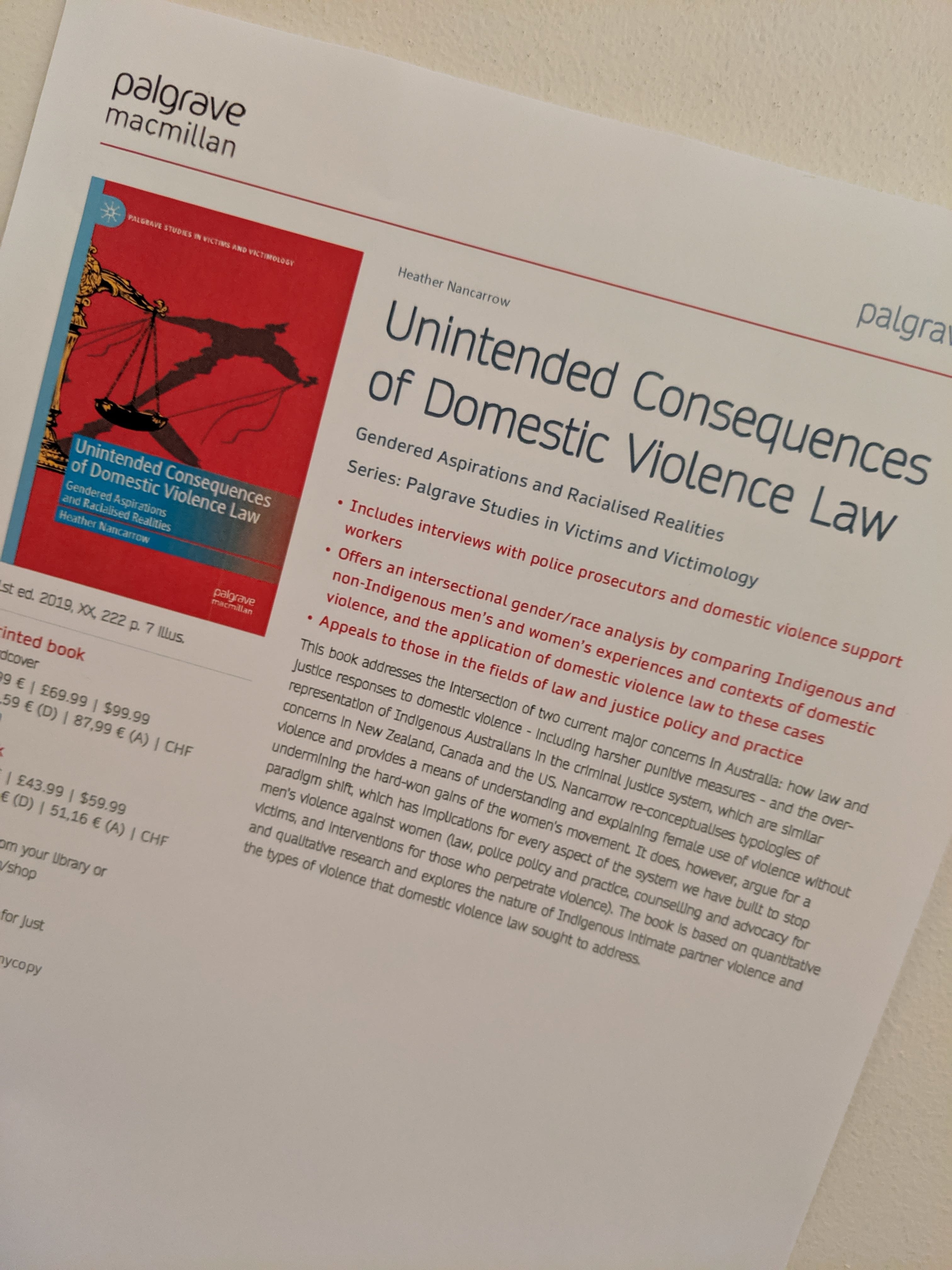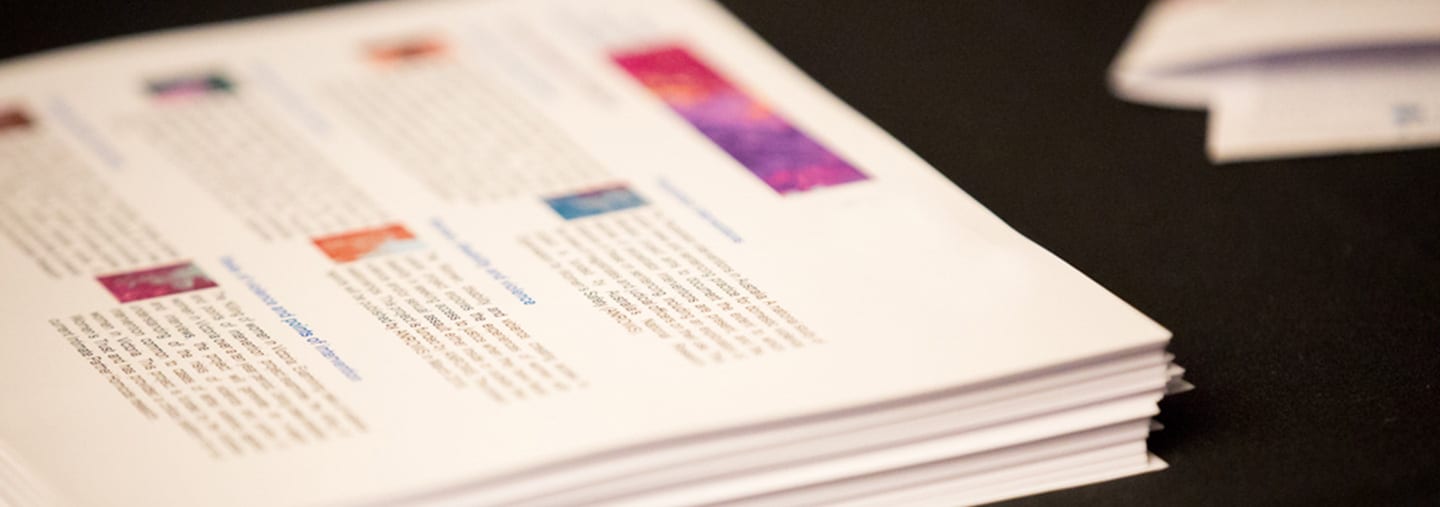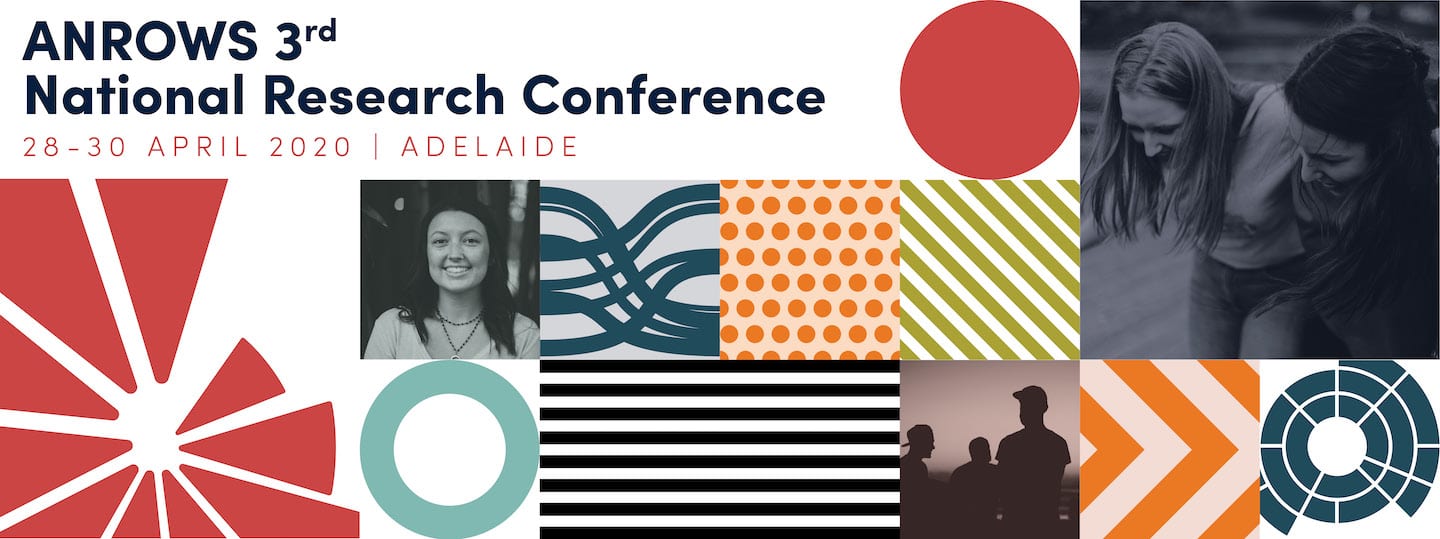NOTEPAD
Intimate partner violence and the law
ANROWS Notepad | 22 August 2019

New Podcast and Video:
Transforming legal understandings of intimate partner violence
Podcast
Despite attempts to reform self-defence laws, in practice, there are significant barriers to raising self-defence for women who have experienced domestic violence and killed their abusive partner.
A new podcast exploring research in this area is now available. Michele Robinson—ANROWS Director, Evidence to Action— sits down with researchers Professor Julia Tolmie (The University of Auckland) and Associate Professor Stella Tarrant (The University of Western Australia) to discuss their ANROWS research project, Transforming legal understandings of intimate partner violence.
The project’s final report centres on a single case, Western Australia v. Liyanage, in which the deceased subjected the defendant to years of abuse, including significant sexual violence.
Download the podcast to hear Julia, Stella and Michele talking about the way legal professionals often understand intimate partner violence (IPV), and how an analysis based on a social entrapment framework can allow for a fairer assessment of the facts in cases involving IPV. You can access the podcast directly on our website or listen on Spotify or Apple podcasts; it will soon also be available on other streaming platforms (including for Android platforms).
This is the pilot episode of Insights, a new podcast series from ANROWS. Stay tuned for more episodes about applying the evidence base to reduce violence against women and their children in Australia.
Video
You can now also access a video recording of a live seminar in which this study and the key findings from the report are discussed.
The seminar features researchers Julia Tolmie and Stella Tarrant together with lawyer George Giudice, who acted as legal counsel in the case that was closely analysed in the report.
This seminar was held at the launch of the report. The video can now be accessed here.

Updated synthesis on intimate partner sexual violence: new case study
During sexual violence awareness month in April, ANROWS released a research synthesis on intimate partner sexual violence (IPSV). The synthesis examined the characteristics of IPSV, current service responses, prevention activities, and recommendations for policy and practice.
Today ANROWS is releasing a second edition of the synthesis with an added case study from the new research report discussed above: Transforming legal understandings of intimate partner violence.
This case study has been used within the synthesis to draw out and illustrate the key points of the paper, namely that IPSV occurs alongside other tactics of domestic violence; that it is difficult to name; that there are barriers to disclosure; that widely-held community attitudes affect the responses of police and the judiciary; and that IPSV is underreported and hard to prosecute.
Content note: This case study contains descriptions of physical and sexual violence, and child abuse.
READ THE PAPER
ANROWS CEO on unintended consequences of DV law
On August 21, ANROWS CEO Dr Heather Nancarrow presented a seminar on legal responses to domestic violence, based on her 2016 doctoral research, available here). Speaking to an audience of lawyers, practitioners, survivor-advocates and researchers, Heather outlined the unintended consequences of civil domestic violence law, originally designed to protect women from a coercive controlling male intimate partner.
Current domestic violence laws have had the effect of criminalising women—mainly Aboriginal and Torres Strait Islander women—through criminal charges for breaching a domestic violence order (DVO): usually a cross-DVO. Based on analyses of court data and police reports, Heather’s research revealed that Indigenous women were more likely than Indigenous men and non-Indigenous men and women, to be subject to a DVO resulting from a police application, and that DVO breach charges against them were more likely to result in a conviction compared to charges against non-Indigenous women. Analysis of data from interviews with service providers and police prosecutors, and police reports of breaches, revealed a number of factors that contribute to the unintended consequences of domestic violence law. These factors are, predominantly:
- The failure to distinguish between coercive control and fights—particularly an understanding of the “chaos” contexts of violence occurring in neo-colonial experiences, environments and structures; and
- Formulaic policing (proscribed act + relevant relationship = domestic violence).
Heather argued that the current laws—which she herself fought hard for as a young feminist in Queensland —remain an important tool for victims/survivors of domestic violence. However, if the decision to apply the law is removed from the aggrieved, the law can become a tool of state control over women.
These complex issues are explained in detail in Heather’s forthcoming book, Unintended Consequences of Domestic Violence Law: Gendered Aspirations and Racialised Realities.

Young Australians’ attitudes to violence against women and gender equality: video
A new video is now available outlining the attitudes of young Australians (aged 16–24) to violence against women, sexual consent, harassment, control in relationships, and other aspects of gender equality.
The video introduces the findings from a major ANROWS report, which analysed youth respondents’ data gathered from the 2017 National Community Attitudes towards Violence against Women Survey, or the NCAS.
This video presents the findings from the NCAS youth report, showing positive results, areas where there is work to be done, and implications for policy and practice. It is a resource for anyone currently working to support the change of knowledge and attitudes among young people.
Learn about the NCAS Youth Report and access the video on our website, or go straight to the video via the button below.
WATCH VIDEO
New Fourth Action Plan is endorsed by governments
ANROWS welcomes the Fourth Action Plan of the National Plan to Reduce Violence against Women and their Children. We look forward to producing, and supporting the uptake of, evidence to effectively advance the plan’s priorities for prevention and response to violence against women and their children.
Grants under this new Action Plan have opened for primary prevention activities. The deadline is 24 September 2019. Find out more here.
READ THE 4APANROWS welcomes …
Professor Dawn Bessarab
Professor Dawn Bessarab was formally appointed to the ANROWS Board on 16 August, and will fill the Independent Director position made vacant by Professor Victoria Hovane’s retirement from the Board in June this year.
Dawn is an Aboriginal woman of Bard (West Kimberley and Yjindjarbandi [Pilbara]) descent. A highly regarded senior social worker and researcher, she is particularly interested in the application of Indigenous research methodologies, participatory action research and the translation of research into policy and practice. Having worked in child protection for the last 20 years, Dawn has extensive experience in the fields of family and domestic violence and drug and alcohol use.
Dawn is a founding and current director on the board of the Family Violence Prevention Legal Service, and is a former chair of Nadine Women’s Refuge (both in Perth).
Dr Christine Coumarelos
Also this month, Dr Christine Coumarelos has joined ANROWS as Director, Research Program (NCAS). Dr Christine Coumarelos is responsible for managing the successful delivery of the National Community Attitudes towards Violence against Women Survey (NCAS). The NCAS is the world’s longest-running periodic survey of community attitudes towards violence against women; first developed in 1995, it was administered by VicHealth in 2009 and 2013, and is now administered by ANROWS.
Christine has more than 25 years of experience in directing research programs to inform policy reform. With a PhD in Psychology from the University of NSW, much of Christine’s work experience has been in the areas of crime and justice and has drawn on criminology and socio-legal studies. She was the lead author in the Legal Australia-Wide (LAW) Survey, the world’s largest legal-needs survey, which now underpins justice policy and legal assistance services in Australia.
ANROWS warmly welcomes both Professor Dawn Bessarab and Dr Christine Coumarelos to our team.
Save the date

New research & resources
Research
Ballan, M. & Freyer, M. (2019). Intimate Partner Violence and Women With Disabilities: The Role of Speech-Language Pathologists. American Journal of Speech-Language Pathology.
Berry, V., Wilkinson, K., Farr, N. et al. (2019). Assessing the Feasibility of a Parent Life Coaching Intervention to Support Parents and Children Who Have Experienced Domestic Violence and Abuse. Journal of Family Violence, 34(6), 493–506.
Callaghan, J.E.M., Fellin, L.C. & Alexander, J.H. (2019). Promoting Resilience and Agency in Children and Young People Who Have Experienced Domestic Violence and Abuse: the “MPOWER” Intervention. Journal of Family Violence, 34(6), 521–537.
Coe, J.L., Parade, S.H., Seifer, R. et al.(2019). Household Chaos Moderates Indirect Pathways Involving Domestic Violence, Parenting Practices, and Behavior Problems among Preschool Children. Journal of Family Violence, 1–12.
Douglas, H. & Nagesh, R. (2019). Domestic and family violence, child support and ‘the exemption’. Journal of Family Studies.
Downes, J., Kelly, L. & Westmarland, N. (2019). ‘It’s a work in progress’: men’s accounts of gender and change in their use of coercive control. Journal of Gender-Based Violence.
Elliffe, R. & Holt, S. (2019). Reconceptualizing the Child Victim in the Police Response to Domestic Violence. Journal of Family Violence, 34(6), 589–600.
Ferrari B. (2019). Gender Violence: Risk Factors and Social Vulnerability. In: Tarricone I., Riecher-Rössler A. (Eds.) Health and Gender. Springer.
Goldblatt, B. (2019). Violence against women and social and economic rights: deepening the connections. In: Rimmer, S. & Ogg, K. (eds), Research Handbook on Feminist Engagement with International Law, Edward Elgar, Cheltenham, pp. 359-378.
Goldblatt, B. (2019). Social and economic rights to challenge violence against women – examining and extending strategies. South African Journal on Human Rights, 35(2).
Karakurt, G., Koç, E., Çetinsaya, E., Ayluçtarhan, Z., Bolen, S. (2019). Meta-analysis and systematic review for the treatment of perpetrators of intimate partner violence. Neuroscience & Biobehavioral Reviews.
Rauvola, R.S., Vega, D.M. & Lavigne, K.N. (2019). Compassion Fatigue, Secondary Traumatic Stress, and Vicarious Traumatization: a Qualitative Review and Research Agenda. Occupational Health Science, 1–40.
Rees S, Simpson L, McCormack CA, Moussa B & Amanatidis S (2019). Believe #metoo: sexual violence and interpersonal disclosure experiences among women attending a sexual assault service in Australia: a mixed-methods study. BMJ Open, 9(7).
Rine, C. & LaBarre, C. (2019) Research, Practice, and Policy Strategies to Stop Family Violence. Health & Social Work.
Rogers, M., Rumley, T. & Lovatt, G. (2019). The Change Up Project: Using Social Norming Theory with Young People to Address Domestic Abuse and Promote Healthy Relationships, Journal of Family Violence, 34(6), 507–519.
Svalin, K. & Levander, S. (2019). The Predictive Validity of Intimate Partner Violence Risk Assessments Conducted by Practitioners in Different Settings—a Review of the Literature. Journal of Police and Criminal Psychology.
Tomlinson, J. (2019). Domestic violence is a major public health issue. Australian Medicine, 31(14).
Resources
Fourth Action Plan under the National Plan to Reduce Violence Against Women and their Children
NSW Women’s Strategy 2018-2022: Two-Year Action Plan
The Line (Our Watch): Practitioner and Educator Resource Library
DV Alert: Working with women with disabilities e-Learning (Free for frontline workers)
Opportunities
Men as Role Models for Preventing Violence against Women and their Children
Community-led Projects to Prevent Violence against Women and their Children
Accredited Training for Sexual Violence Responses
Give your feedback: Review of the Family Violence Information Sharing Scheme
In the media
Watch
The COAG plan to reduce domestic violence – The Drum
Author of Women, Men & the Whole Damn Thing, David Leser, on the ‘First act of the patriarchy’ – The Drum
Listen
ANROWS Insights: Transforming legal understandings of intimate partner violence (podcast)
Read
Calls for Centrelink to change the rules regarding couples – Your Life Choices
The link between lone attacks and violence against women hides in plain sight – ABC
Next student survey on sexual assault and sexual harassment to run in 2020 – Universities Australia
Sex abuse victims, betrayed by confidants, at risk of worse trauma: study – SMH
Finally, she can speak – ABC
Tasmania sex assault gag law to face overhaul early next year – The Guardian
Chance meeting leads to Archibald Prize People’s Choice win – SMH
We’re raising a generation of young men with their fathers’ misogyny and violence – WA Today
When Domestic Abuse Destroys Your Childbirth Plan – VICE
Violence against women to stay ‘static’ until gender roles change, says COAG plan – SMH
The latest action plan to tackle violence against women isn’t perfect, but it takes a much-needed holistic approach – The Conversation
Announcing the finalists of the 2019 Women’s Agenda Leadership Awards – Women’s Agenda
When He Throws Your Birth Control Pills in the Garbage – VICE
Push for real-time count of women killed by violence – SMH
Fears fewer migrants will report family violence over deportation fears – SBS
Case in Victoria could set new legal precedent for stealthing, or removing condom during sex – The Conversation
Conferences & events
Conferences
Sydney, 5–6 September 2019: Imagining a World Without Gendered Violence: the 2019 DVNSW conference
Melbourne, 11 September 2019: Bystander Action to Prevent Violence Against Women (Women’s Health Victoria)
Perth, 14-16 Oct 2019: Stopping Family Violence conference on Intersectionalities in Domestic Violence
Cape Town, South Africa, 21-25 October 2019: 6th Global Conference on Violence Against Women
Kaohsiung, Taiwan, 5–8 November 2019: The 4th World Conference of Women’s Shelters
Hunter Valley, NSW, 19–22 November 2020: Family and Relationship Services Australia (FRSA) Conference: New Horizons: Building the future, Paving the way
Gold Coast, 9-11 Dec 2019: 9th Stop Domestic Violence National Indigenous Conference
Adelaide, 28-30 April 2020: ANROWS 3rd National Research Conference
Siem Reap, Cambodia, 26–29 May 2020: 10th Asia-Pacific conference on reproductive and sexual health and rights
Melbourne, 10-12 June 2020: AIFS 2020 Conference: What is a good life for families? And how do we get there?
Sweden, 30 June – 2 July, 2020: 23rd Conference of the Nursing Network on Violence Against Women International
Training & events
Sydney, 24 August – 23 November 2019: Exhibition launch for “Amani Haydar: The mother wound”
Melbourne, 28 August 2019: No to Violence: Active Bystander Training
Sydney, 31 August 2019: Telling truths – researching the story, a conversation with Jane Caro and Bri Lee (Author of Eggshell Skull)
Adelaide, 12 September 2019: Human Trafficking and Modern Slavery in South Australia Forum
Sydney, 24 September: Australian Academy of the Humanities: Gender-based Violence Roundtable
Melbourne, 24 September: Responding to women from refugee and migrant backgrounds who are experiencing family violence
Melbourne, 30 September–4 October 2019: Realist Research and Evaluation, Five-day intensive Workshop
Melbourne, 17 October 2019: Family violence awareness for culturally specific or faith-based organisations and communities
Melbourne, 23 October 2019: Towards Gender Transformative Change: Challenge and Opportunities to Prevent Violence Against Women Practice Masterclass (Women’s Health Victoria)
Melbourne, 13 November 2019: Storytelling for Change: Prevention of Violence Against Women Communication Masterclass (Women’s Health Victoria)
Contribute to Notepad
If you have publications, resources, opportunities or events to promote, please forward them to [email protected].
Preferred format is a very brief outline (maximum 4 lines) and a link to further information.


